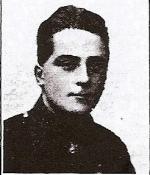
|
The King's School Canterbury |
Roll of Honour |
| Driver St John Arthur Paul METHUEN (42713) | |
|
12th Battery, 3rd Ammunition Column, 9th Brigade, Canadian Field Artillery Date of birth: 19th November 1892 Date of death: 20th July 1918 Died of wounds aged 25 Buried at Bagneux British Cemetery Plot III Row F Grave 2 |

|
| He was born at Puncknowle Rectory, near Bridport in Dorset on the 19th of November 1892 the eldest son of the Reverend St John Frederick Methuen, Rector of Vange, and Louisa Elizabeth (nee Champion), later of Vange Rectory, Pitsea in Essex. He was christened by his father at the Church of St Mary the Virgin, Puncknowle on the 1st of January 1893. He was educated at Chigwell School, at Edgeborough House School, Guildford and at the King's School Canterbury from May 1907 to July 1910, after which he worked as a clerk for a fur broker. In March 1912 he went to Canada where he settled in Aylmer Ontario as a farmer and served for two years in the Canadian Militia. On the outbreak of war he enlisted in the army at Valcartier Camp, Quebec on the 24th of September 1914. At a medical examination, which was held on the 3rd of September 1914, it was recorded that he was five feet nine inches tall with brown eyes, black hair and a dark complexion. He was one of the first six men to arrive at Valcartier Camp. He was posted to the 3rd Brigade, Canadian Field Artillery Ammunition Column. He sailed for England with the first Canadian contingent on the 29th of September 1914 and, after training, he embarked for service in France with the 1st Canadian Division from Avonmouth on the 11th of February 1915. He saw action during the 2nd Battle of Ypres in April/May 1915 and at Givenchy in June 1915. In 1916 he transferred to 45 Battery, 9th Division which was being formed in France. On the 20th of November 1916 he was sentenced to twenty one days Field Punishment for neglecting to obey an order. He took part in the Battles of the Somme and Arras. He was wounded in the left hand at Vimy in July 1917 and was admitted to No. 8 Red Cross Hospital. He was invalided back to England on board the Hospital Ship "Stad Antwerpen" and was admitted to Wharncliffe War Hospital at Sheffield on the 1st of August 1917. The next day they recorded: - "Splinters of wood in left hand and subsequent sepsis. Incised and drained. Wound nearly healed. Hot soaks and Lysol dress. "He was transferred to the Canadian Convalescent Hospital at Woodcote Park, Epsom on the 28th of August where was declared to be free from the infection in his hand on the 6th of September and was discharged to duty on the 12th of September 1917. He returned to France on on the 30th of November 1917 where he joined the Canadian Artillery Pool. The following day he was arrested for drunkenness and, on the 8th of December, he was sentenced to fourteen days of Field Punishment No. 2 and forfeited twenty one day's pay. He was posted to 20th Battery, 9th Brigade Canadian Field Artillery on the 11th of January 1918 and joined them in the field two days later. On the 19th of July 1918 he was severely wounded in the left leg by a shrapnel following a direct hit from a shell during a period of heavy shelling at Doullens. He was evacuated to 56 Casualty Clearing Station where he died the next day following an operation to amputate his left leg. His Commanding Officer wrote: - "He was fatally wounded on July 19th while on duty by a direct hit during heavy shelling. He was removed at once to the casualty clearing station and everything was done to save him but the shock was too great and he passed peacefully away at 1am on the 20th aged 25 years. He died the noblest of deaths, in the service of his country and was a splendid type of Britain's sons. I feel his loss keenly as he always set an example to his comrades in cheerfulness, devotion to duty and high personal standard and was truly beloved by his fellow gunners, who will miss him greatly." He is commemorated on the war memorial at Vange, Essex. |
|
| Holme House |
Back